Dean Phillips’ Master’s National TT Championship Winning Cervelo S5
At Fit Werx in MA and VT we often get questions about what our resident Cat 1 racer and ’14 Masters National Champion on the track and in the TT is riding. The short answer is that Dean rides a host of bikes. These range from his Seven 622 SLX that he stacks on the training miles; to his very fast Cervelo P5 tri/TT bike and S5 road race bike; to his new Seven Mud Honey SL that is being built for cyclocross and off season use in Massachusetts. Dean knows that the right tool for the job makes the difference and can you really ever have too many bikes?!?
TT Nationals were held recently and Dean took home a National Championship for Team Fit Werx and thus we have had a number of inquiries about Dean’s championship winning set-up for TT Nationals in Utah. So, without further ado, here is what Dean rode for equipment and his words on why he selected each item for this event.
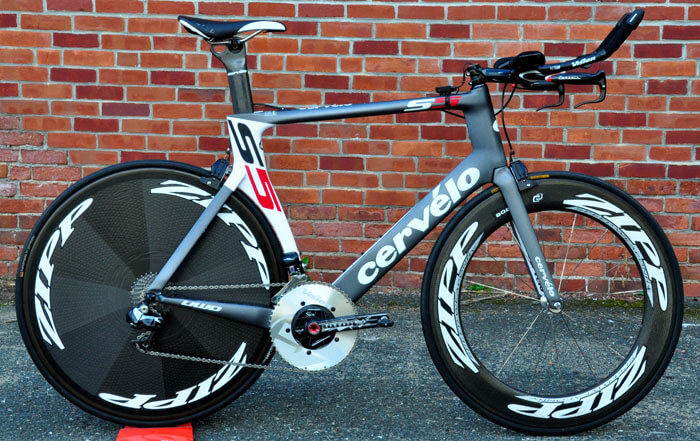
Frame & Positioning – Cervelo S5 VWD. “The main reason for the Cervelo S5 VWD road frame was the big limitation of how short reach needs to be to remain UCI-legal for Masters Nationals. They now only allow 80cm maximum horizontal distance from the bb to the most distant part of the shifter, including the shift lever! At 6’3”, this is a major limiting factor for me and forces me to ride with a comparatively laid back seat position just to keep the reach to the bars reasonable. I can’t stay within the rule with a forward seat position TT specific frame. I had started testing aero results on my Cervelo S5 road race frame for the Green Mountain Stage Race as the TT at that race does not allow TT specific bikes, so I just continued refining that position for Nationals.
After a host of field testing, my actual saddle position ended up being the same as what I use on my road bike. So, I swapped out the road bar on the Cervelo S5 for aerobars and started tweaking the position from there with further field aero testing with my power meter. I actually was able to get a lower CdA than my fastest position I could find on my non-UCI legal Cervelo P5 with a more forward saddle position. However, this was not without compromise. My TT position on the S5 loses power compared to my aero position on my Cervelo P5. Initially, this was a significant 30-40 watts, but with a lot of training I have it down to 20 watts now. I’ve always had trouble finding a UCI-legal position that tested as fast as my forward-longer tri positions, but I finally found it with this setup.
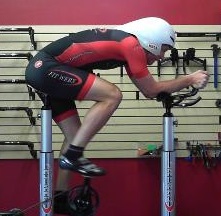 This being said, the aero position on the S5 was not a particularly comfortable position (thank you UCI!); it was a struggle staying in the aerobars for even the 44 minutes at Nationals, and I’d definitely have a hard time using it for a longer event like a triathlon. CdA is between 0.22 and 0.23 depending on wind – which is low for a 6’3 198 lb rider. I noticed this past year that Tom Zirbel won the Pro TT Nationals on a road frame – so other taller guys are thinking the same thing in working around the silly UCI rules.”
This being said, the aero position on the S5 was not a particularly comfortable position (thank you UCI!); it was a struggle staying in the aerobars for even the 44 minutes at Nationals, and I’d definitely have a hard time using it for a longer event like a triathlon. CdA is between 0.22 and 0.23 depending on wind – which is low for a 6’3 198 lb rider. I noticed this past year that Tom Zirbel won the Pro TT Nationals on a road frame – so other taller guys are thinking the same thing in working around the silly UCI rules.”
Group – Shimano 9070 Di2. Dean’s Words: “This was an easy decision as the Di2 shift levers are actually shorter than mechanical shift levers since they don’t stick out horizontally. Di2 is beneficial for taller riders pushing the reach limitation of the UCI rules. Di2 also shifts great and is almost ideal for TT/Tri set-ups as they not only work really well in terms of shift quality, but they have also been testing as the most aero in many cases as well. The Di2 junction box went on the top tube which was a last-minute decision since it allowed them to run the cables cleanly. We tried it above the stem as well, but figured why not just hide it from the wind behind the steerer tube.”
Wheelset & Tires – Zipp 808 & Super9 Carbon Clincher w/Continental Supersonic Tires & Latex Tubes: Dean’s Words: “I used the Zipp 808 and Zipp Super9 carbon clincher wheels, with Continental Supersonic 700×23 tires and Vittoria latex tubes. The Supersonic 700×23 tires are still the fastest rolling tires I’ve ever tested, and they’ve remained durable for a race tire for me even on New England’s often rough roads. I’ve used these tires for every race (outside of Battenkill,…), on the B2B the last 3 years, and on many training rides as well. They’re out of production, so hopefully some of the new ultra-low rolling resistance tire options entering the market will do what they claim and fill that void.
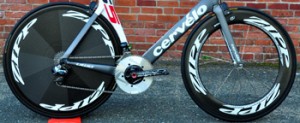 I ran a pair of Zipp 808s for my fastest two time trials this summer in Massachusetts, and in the back of my mind I was thinking the rear 808 may be the same or faster than the Super9 disc. The rear Zipp 808 just felt smoother than the disc – and I made a case in my head that the Zipp 808 soaked up the crummy roads better on the Charlie Baker TT course in Concord, MA than the Zipp Super9 disc. However, I eventually field aero tested the 808 and Super9 disc on the same morning – driving my car out to my course and spending an hour swapping the two rear wheels back and forth (making sure the tire circumferences where the same, and same tires/tubes used – even the same wear on the tires used for both the 808 and Super9). In the end, the Super9 appeared the same or slightly faster than the 808 rear in the light wind conditions I tested – I summed it up at a 1-3 watt benefit. Trendlines where clearly sloping in favor of the disc, so I went with it.”
I ran a pair of Zipp 808s for my fastest two time trials this summer in Massachusetts, and in the back of my mind I was thinking the rear 808 may be the same or faster than the Super9 disc. The rear Zipp 808 just felt smoother than the disc – and I made a case in my head that the Zipp 808 soaked up the crummy roads better on the Charlie Baker TT course in Concord, MA than the Zipp Super9 disc. However, I eventually field aero tested the 808 and Super9 disc on the same morning – driving my car out to my course and spending an hour swapping the two rear wheels back and forth (making sure the tire circumferences where the same, and same tires/tubes used – even the same wear on the tires used for both the 808 and Super9). In the end, the Super9 appeared the same or slightly faster than the 808 rear in the light wind conditions I tested – I summed it up at a 1-3 watt benefit. Trendlines where clearly sloping in favor of the disc, so I went with it.”
Aerobars and Basebar – HED Corsair and Vision 250TT. Dean’s Words: “My basebar 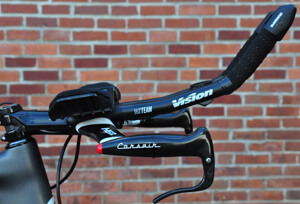 was a Hed Corsair UCI-legal model with the integrated brake levers. They are super aero, and allow for independent aerobar tilt adjustment which I needed. I can’t use the Di2 auxiliary shift buttons with this basebar, but most of my TTs don’t involve climbing while holding the basebar so that didn’t matter. The aerobars were the somewhat clunky and old Vision 250TT alloy extensions. I originally clipped a pair of these on my road bar setup for all the field testing, and then transferred them over to the TT setup on the Hed Corsair basebar so I’d be in the same exact position. I had planned on swapping them out to something lighter this summer, but it didn’t happen.
was a Hed Corsair UCI-legal model with the integrated brake levers. They are super aero, and allow for independent aerobar tilt adjustment which I needed. I can’t use the Di2 auxiliary shift buttons with this basebar, but most of my TTs don’t involve climbing while holding the basebar so that didn’t matter. The aerobars were the somewhat clunky and old Vision 250TT alloy extensions. I originally clipped a pair of these on my road bar setup for all the field testing, and then transferred them over to the TT setup on the Hed Corsair basebar so I’d be in the same exact position. I had planned on swapping them out to something lighter this summer, but it didn’t happen.
I tested aerobar pad width and extension angle more then anything this past summer. They were all fast, but there was a sweet spot for me from 7-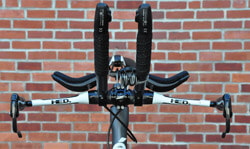 10 degrees that tested fastest. It didn’t seem to matter if I went slightly up or down from this point, or adjusted the pads narrower or wider from this point. This gave me a solid position that allowed for all the little movements while holding the aerobars without a drag penalty. This was new for me, since all testing on my Cervelo P5 setups (steeper seat angle and longer reach) in the past resulted in aerobars tilting up being slower for me. This just demonstrates that when it comes to aerodynamics, everything is connected and you should not just make assumptions.”
10 degrees that tested fastest. It didn’t seem to matter if I went slightly up or down from this point, or adjusted the pads narrower or wider from this point. This gave me a solid position that allowed for all the little movements while holding the aerobars without a drag penalty. This was new for me, since all testing on my Cervelo P5 setups (steeper seat angle and longer reach) in the past resulted in aerobars tilting up being slower for me. This just demonstrates that when it comes to aerodynamics, everything is connected and you should not just make assumptions.”
Brakes – 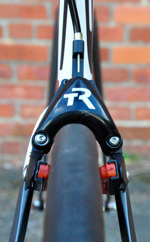 TriRig Omega Brakes. “The TriRig Omega Brakes really look nice and aero on the frame and I liked that. Also, more importantly, when Damon Rinard from Cervelo was here doing his aero presentation at Fit Werx in Peabody, MA last spring, I’d asked him about the TriRig Omega brakes and he said he’s seen data showing them more aero then regular brakes on the S5. I never could test them myself, so I just pushed the “I-believe button” on this one.”
TriRig Omega Brakes. “The TriRig Omega Brakes really look nice and aero on the frame and I liked that. Also, more importantly, when Damon Rinard from Cervelo was here doing his aero presentation at Fit Werx in Peabody, MA last spring, I’d asked him about the TriRig Omega brakes and he said he’s seen data showing them more aero then regular brakes on the S5. I never could test them myself, so I just pushed the “I-believe button” on this one.”
Saddle – Fizik Aliante. “The Fizik is one of my favorite road saddles, but it is not exactly the TT/Tri saddle I recommend for most riders… I used the same exact position as my road bike which meant I didn’t have to spend as much time on it since muscle memory is similar. This was important to me in this event and the Fizik Aliante was working for me on this relatively short distance (compared to a 1/2 Ironman or Ironman…).”
Aero Helmet – Bell Javelin: “We tested the Bell Javelin when it first came out when we were writing an article for Triathlete Magazine’s “Buyer’s Guide” and we were really  impressed with its versatility, fit and price. The Bell Javelin tested faster for me than my trusted old LG Rocket helmet which used to beat everything else. The Bell Javelin also seems to be versatile in that it didn’t matter what angle I tilted it on my head – it was always fast. I even tested with and without the visor too as I race without the visor since there’s a massive difference in how much wind I feel on my face which helps with that overheated feeling. I couldn’t detect a difference in the field testing results between visor and no visor on the Bell Javelin and I can also hear oncoming cars more without the visor – with the visor on it sounds like I’m flying in an airplane with background noise. Weird!”
impressed with its versatility, fit and price. The Bell Javelin tested faster for me than my trusted old LG Rocket helmet which used to beat everything else. The Bell Javelin also seems to be versatile in that it didn’t matter what angle I tilted it on my head – it was always fast. I even tested with and without the visor too as I race without the visor since there’s a massive difference in how much wind I feel on my face which helps with that overheated feeling. I couldn’t detect a difference in the field testing results between visor and no visor on the Bell Javelin and I can also hear oncoming cars more without the visor – with the visor on it sounds like I’m flying in an airplane with background noise. Weird!”
Gloves – Castelli Aero Gloves. “I tested Castelli Aero Gloves – the new ones that just came out this season. While they claim 8 watts of savings, I got what looked like 1-2 watts the day I tested with them, without them, and then with them again. I’ve used the Castelli Aero Gloves for all TT’s this season as every watt can matter if you are looking to set a PR.”
Skinsuit – Castelli Body Paint 3.0: “I used the Castelli Body Paint 3.0 skinsuit. I have a half-dozen nice skinsuits at this point, but I got the Castelli suit just to test this summer. I never tested it conclusively against a different suit on the same day, but it felt so fast and I got a low CdA the day I tested it. I seriously think part of the benefit is its so tight around my shoulders that it squeezes them together and takes less physical effort for me to squeeze them and that conserves energy. I use an XL and it still takes a while to put it on – you really can’t stand up once you have it on. I saw dozens of these suits at Nationals – so it seems to be the consensus fastest suit out there right now. The Castelli Body Paint 3.0 skinsuit can be hard to get, so give us a call early in the winter to get one before the season. I set a Massachusetts TT course record this year by 5 seconds and I won a regional TT championship by just 3 seconds, so every little watt saved was important this summer!”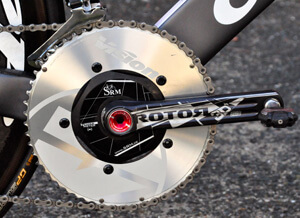
Gearing: “I used a 55-tooth 11-speed Vision chainring which shifted flawlessly with the Di2. I really like how it looks too. After spinning it out for a while in the crazy tailwind at nationals I was wishing I had a 58×11!”
Booties: “I don’t use booties, since when I put them on my Bont shoes the buckle makes them look much wider. I’ve just gone without after testing for myself personally. Most other folks would likely see an aero benefit with booties.”
 Important Note: While what equipment Dean uses can be helpful for most anyone looking to maximize their performance on a bike, remember that aerodynamics is not universal and that the things that work best for one rider may or may not work ideally for another. Be sure to get your baseline position dialed in first (a Fit Werx bike fitting is a great place to start…) and then work with your fitter to find some great baseline equipment that you can start collecting your own data on to learn more.
Important Note: While what equipment Dean uses can be helpful for most anyone looking to maximize their performance on a bike, remember that aerodynamics is not universal and that the things that work best for one rider may or may not work ideally for another. Be sure to get your baseline position dialed in first (a Fit Werx bike fitting is a great place to start…) and then work with your fitter to find some great baseline equipment that you can start collecting your own data on to learn more.

